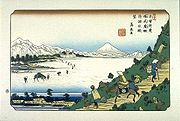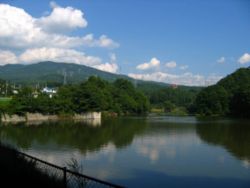
Shiojiri-shuku
Encyclopedia


69 Stations of the Nakasendo
The are the rest areas along the Nakasendō, which ran from Nihonbashi in Edo to Sanjō Ōhashi in Kyoto. The route stretched approximately and was an alternate trade route to the Tōkaidō.-Stations of the Nakasendō:...
of the Nakasendō
Nakasendo
The , also called the , was one of the five routes of the Edo period, and one of the two that connected Edo to Kyoto in Japan. There were 69 stations between Edo and Kyoto, crossing through Musashi, Kōzuke, Shinano, Mino and Ōmi provinces...
. It is located in the central part of the present-day city of Shiojiri
Shiojiri, Nagano
is a city located in Nagano, Japan. Its name literally means "the end of salt".-History:Municipal Area Changes* April 1, 1927-The village of Shiojiri gained town status....
, Nagano Prefecture
Nagano Prefecture
is a prefecture of Japan located in the Chūbu region of the island of Honshū. The capital is the city of Nagano.- History :Nagano was formerly known as the province of Shinano...
, Japan
Japan
Japan is an island nation in East Asia. Located in the Pacific Ocean, it lies to the east of the Sea of Japan, China, North Korea, South Korea and Russia, stretching from the Sea of Okhotsk in the north to the East China Sea and Taiwan in the south...
.
History
This area was originally built by Ōkubo NagayasuOkubo Nagayasu
was a Japanese samurai of the Edo period who served the Tokugawa clan. He worked as a mining magistrate in various Tokugawa-controlled mines. Due to misconduct, he was deprived of office, and died soon afterward.-References:*http://fine-vn.com/cat_11/ent_60.html...
in the Keichō era
Keicho
was a after Bunroku and before Genna. This period spanned from October 1596 to July 1615. The reigning emperors were and .-Change of era:* 1596 : The era name was changed to Keichō to mark the passing of various natural disasters...
of the early Edo period
Edo period
The , or , is a division of Japanese history which was ruled by the shoguns of the Tokugawa family, running from 1603 to 1868. The political entity of this period was the Tokugawa shogunate....
. There was a shorter route along the Nakasendō that connected Shimosuwa-shuku
Shimosuwa-shuku
was the twenty-ninth of the sixty-nine stations of the Nakasendō, as well as being the ending location of the Kōshū Kaidō. It is located in the present-day town of Shimosuwa, Suwa District, Nagano Prefecture, Japan.-History:...
and Niekawa-juku
Niekawa-juku
was the thirty-third of the sixty-nine stations of the Nakasendō. It is located in the present-day city of Shiojiri, Nagano Prefecture, Japan.-History:...
directly, but the route was changed to include this post town, as well as Seba-juku
Seba-juku
was the thirty-first of the sixty-nine stations of the Nakasendō. It is located in the central part of the present-day city of Shiojiri, Nagano Prefecture, Japan.-History:...
and Motoyama-juku
Motoyama-juku
was the thirty-second of the sixty-nine stations of the Nakasendō. It is located in the central part of the present-day city of Shiojiri, Nagano Prefecture, Japan.-History:...
, after Ōkubo's death. It eventually became the connecting post town between Shimosuwa-shuku and Seba-juku
Seba-juku
was the thirty-first of the sixty-nine stations of the Nakasendō. It is located in the central part of the present-day city of Shiojiri, Nagano Prefecture, Japan.-History:...
. During its most prosperous period, there were over 70 buildings in the town and it thrived as one of the kokudaka
Kokudaka
refers to a system for determining land value for tribute purposes in Edo period Japan and expressing this value in koku of rice. This tribute was no longer a percentage of the actual quantity of rice harvested, but was assessed based on the quality and size of the land...
of the Matsumoto Domain
Matsumoto Domain
The ' was a Japanese feudal domain in Shinano Province . Home to a major strategic center in the form of Matsumoto Castle, it was ruled by various families during the course of its history, the Hotta among them.-List of Daimyo:...
. Because of its size, it was divided into "upper," "central" and "lower" portions. During the Meiji period
Meiji period
The , also known as the Meiji era, is a Japanese era which extended from September 1868 through July 1912. This period represents the first half of the Empire of Japan.- Meiji Restoration and the emperor :...
, there was a large fire, which destroyed most of the town.
The post station also served as one terminus for the Sanshū Kaidō, a trade route which brought salt to Japan's interior. Records show that in 1843, Shiojiri-juku had 794 residents and 166 buildings. Among the building, there was one honjin
Honjin
thumb|250px|The honjin at [[Inaba Kaidō]]'s [[Ōhara-shuku]]. is the Japanese word for an inn for government officials, generally located in post stations during the later part of the Edo period.-Evolution of Honjin:...
, one sub-honjin, and 75 hatago
Hatago
were Edo period lodgings for travelers at shukuba along the national highways, including the Edo Five Routes and the subroutes. In addition to a place to rest, hatago also offered meals and other foods to the travelers...
.
Neighboring post towns
Nakasendō- Shimosuwa-shukuShimosuwa-shukuwas the twenty-ninth of the sixty-nine stations of the Nakasendō, as well as being the ending location of the Kōshū Kaidō. It is located in the present-day town of Shimosuwa, Suwa District, Nagano Prefecture, Japan.-History:...
- Shiojiri-shuku - Seba-jukuSeba-jukuwas the thirty-first of the sixty-nine stations of the Nakasendō. It is located in the central part of the present-day city of Shiojiri, Nagano Prefecture, Japan.-History:...
Shio no Michi's Sanshū Kaidō
- Shiojiri-shuku (starting location) - Ono-juku

